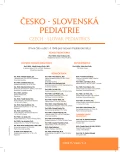Rectal suction biopsy in clinical practice
Authors:
J. Škvařil; D. Starý; J. Tůma; L. Plánka
Authors‘ workplace:
Klinika dětské chirurgie, ortopedie a traumatologie, Fakultní nemocnice Brno
přednosta prof. MUDr. L. Plánka, Ph. D.
Published in:
Čes-slov Pediat 2016; 71 (4): 208-211.
Category:
Original Papers
Overview
Introduction:
In diagnosing of the Hirschsprung's disease in clinical practice, in addition to radiological diagnosing by irrigography, is often used a histological diagnosing. Invasive diagnostics method during excision from the rectum shows us the presence of ganglion cells in the submucosal layer. But there is an alternative minimally invasive method to the classical excision by using a suction probe which takes a sample of adequate mucosa and submucosal layer of rectum.
Material and methods:
At our department „RBI system“ (rectal biopsy system) was put into practice for tissue sampling. The system uses vacuum biopsy where tissue is sucked into a sterile disposable capsule and cut necessarily large sample by embedded sharp knife. By vacuum biopsy we took samples of tissue from 15 patients aged from 2 months to 12 years with problems of constipation in order to clarify and precise diagnosis.
Results:
The presence of ganglion cells or describes the structure of the rectal mucosa and submucosal layers were determined in 13 cases after histological processing. 6 patients in the study group were diagnosed by Hirschsprung's disease. Another 3 patients were diagnosed as insufficient resection of fistula after PSARP operation, 2 patients were diagnosed as stenosis and elongated anal canal (funnel anus) and last 4 patients as other bowel movement disorders.
Conclusion:
The results show that the system of suction biopsy fully replaces the traditional excision of the rectum layer and bring us equivalent results with minimal complications. It is an ideal method for early diagnosis of Hirschsprung disease in the group age 0–4 years and thanks to this method we can easily diagnose the cause of constipation and differentiate the surgical cause from other causes of constipation.
Key words:
rectal suction biopsy, Hirschsprung's disease, diagnosing
Sources
1. Kobayashi H, Li Z, Yamataka A, et al. Rectal biopsy: what is the optimal procedure? Pediatr Surg Int 2002 Dec; 18 (8): 753–756. Epub 2002 Sep 13.
2. Montedonico S, Piotrowska AP, Rolle U, Puri P. Histochemical staining of rectal suction biopsies as the first investigation in patients with chronic constipation. Pediatr Surg Int 2008 Jul; 24 (7): 785–792. doi: 10.1007//s00383-008-2173-1. Epub 2008 May 8.
3. Warren M, Kaul A, Bove K. Calretinin-immunoreactive hypoinnervation in Down syndrome (DS): report of an infant with very short-segment Hirschsprung disease (vsHD) and comparison to biopsy findings in 20 normal infants and 11 infants with DS and chronic constipation. Pediatr Dev Pathol 2016 Mar-Apr; 19 (2): 87–93. doi: 10.2350/15-01-1602-OA.1. Epub 2015 Jul 31.
4. Meinds RJ, Kuiper GA, Parry K, et al. Infant‘s age influences the accuracy of rectal suction biopsies for diagnosing of Hirschsprung‘s disease. Clin Gastroenterol Hepatol 2015 Oct; 13 (10): 1801–1807. doi: 10.1016/j.cgh.2015.04.186. Epub 2015 May 29.
5. Friedmacher F, Puri P. Rectal suction biopsy for the diagnosis of Hirschsprung‘s disease: a systematic review of diagnostic accuracy and complications. Pediatr Surg Int 2015 Sep; 31 (9): 821–830. doi: 10.1007//s00383-015-3742-8. Epub 2015 Jul 9.
6. Tang YF, Chen JG, An HJ, et al. High-resolution anorectal manometry in newborns: normative values and diagnostic utility in Hirschsprung disease. Neurogastroenterol Motil 2014 Nov; 26 (11): 1565–1572. doi: 10.1111//nmo.12423. Epub 2014 Sep 27.
7. Dahshan A. Serious rectal bleeding complicating suction rectal biopsy in a child. W V Med J 2014 Mar-Apr; 110 (2): 34–35.
8. Pini-Prato A, Carlini C, Pesce F, et al. Massive bleeding after rectal suction biopsy: uncommon and unexpected delayed onset. World J Pediatr 2011 Feb; 7 (1): 83–85. doi: 10.1007/s12519-011-0251-2. Epub 2010 Dec 30.
9. Croffie JM, Davis MM, Faught PR, et al. At what age is a suction rectal biopsy less likely to provide adequate tissue for identification of ganglion cells? J Pediatr Gastroenterol Nutr 2007 Feb; 44 (2): 198–202.
Labels
Neonatology Paediatrics General practitioner for children and adolescentsArticle was published in
Czech-Slovak Pediatrics

2016 Issue 4
Most read in this issue
- How to assess high-sensitive troponin T in newborns?
- Current perspectives on inherited bone marrow syndromes
- Rectal suction biopsy in clinical practice
- Bonding support after child birth
